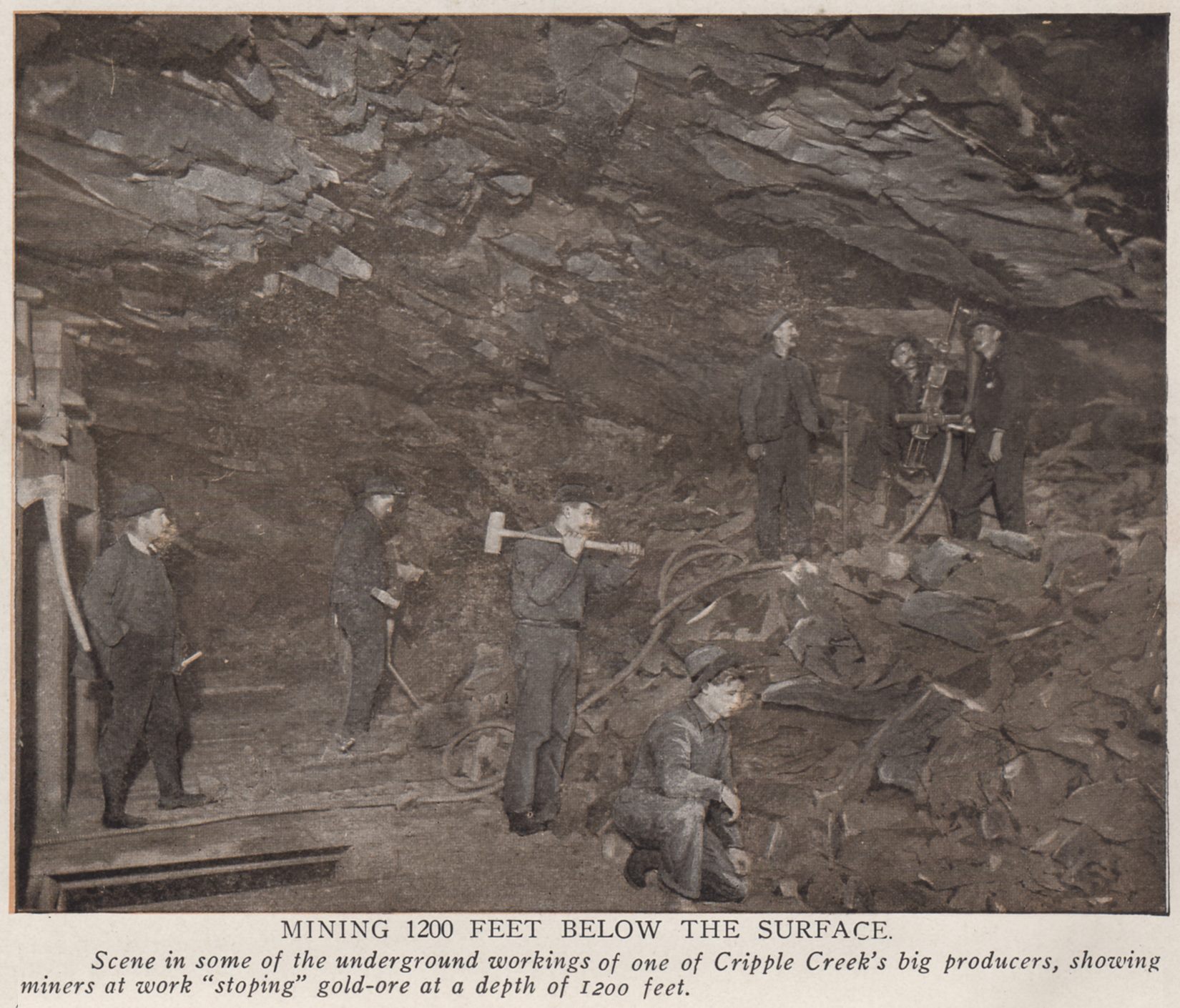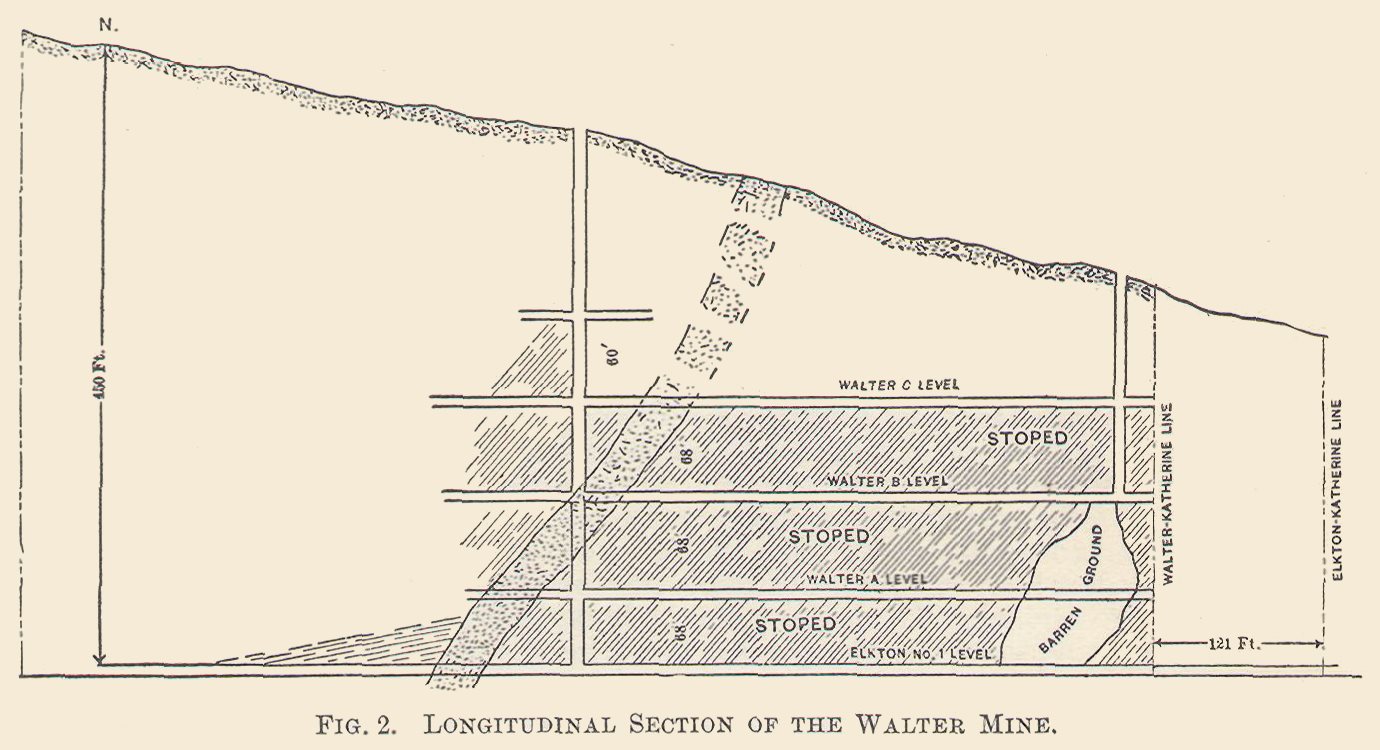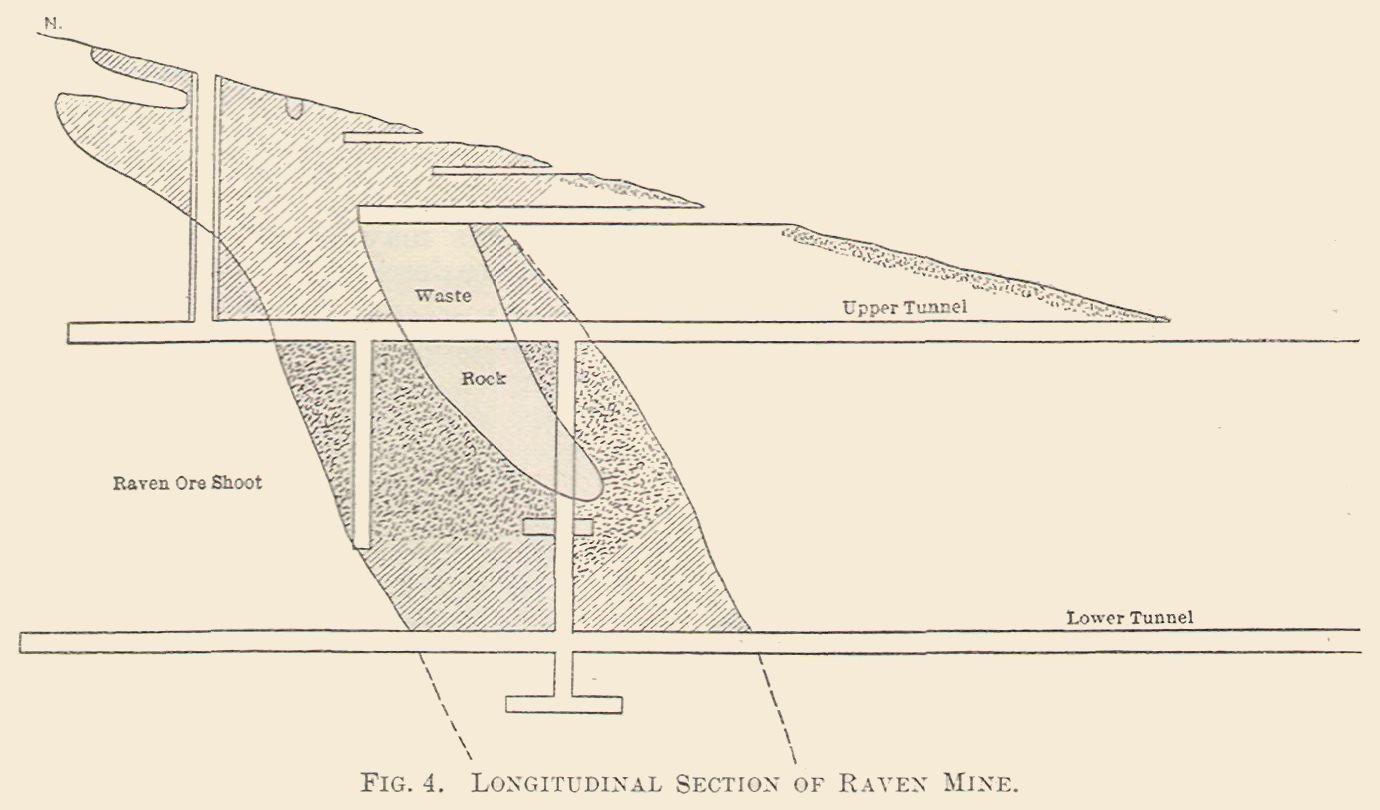-> My Collection; No source to show as I've not shared the Mining Journal as an album.
But, here is a link to first page on Hathi Trust Digital Library website.
June, 1897 (page 481->482)
Source had no images, only four sketches/drawings, so I used a couple of images from my collection.
It must not be supposed that an ordinary metalliferous or gold or silver-bearing vein is a solid mass of metalliferous ore from wall to wall; such is a very rare occurrence. Commonly the vein consists of a thick body of quartz from wall to wall occupying the full width of the original fissure, and the ore-body is either a narrow body in the center of this or distributed in narrow veins or stringers through the quartz, the quartz, or vein stuff or gangue as it is variously called, being largely in the majority. Nor even is this same narrow body or pay streak of metal liable to be entirely continuous either longitudinally or vertically with depth.
On the contrary on entering a tunnel driven in on the outcrop of large metalliferous fissure veins, you may look up on the roof of the tunnel and there observe a narrow dark streak, commonly very rusty, but showing here and there glistening patches of ore, this you are told is the ore body or pay streak, but following this on for some little distance in the tunnel you are apt to find it slowly giving out and the line of the ore only defined by a dark line or by occasional spots of ore. By and by you come to another similar, or it may be still wider body, and so on at intervals to the end of the tunnel. Now supposing this to be the highest tunnel opened on the course of the vein down the mountain side, if you descend to a second lower tunnel on the same vein you may recognize the same body of ore in the roof, through perhaps somewhat further into the tunnel than the previous one ; and at the bottom tunnel you recognize the same ore-body still further in the pit.
This shows that this "ore-shoot" or patch of ore is continuous downward in a slanting or dipping direction. The other ore-bodies or ore-shoots may be found to act similarly. So in a fissure vein, ore-shoots may be considered as long, more or less continuous patches of ore descending and following the downward dip of the vein, separated from one another by comparatively barren intervals and usually having one steep prevailing direction of dip, either north or south as it may be. This is what miners mean by ore-shoots, and such are very characteristic of the fissure veins of Cripple Creek, as described by Mr. Edward Skewes in a paper read before the American Institute Mining Engineers, Sept., 1896.
Mr. Penrose says: "The gold is not uniformly distributed throughout the vein fissures, but is relatively concentrated in oreshoots. These Cripple Creek shoots are of varying shapes and richness, and they trend in varying directions in the fissures, though possibly a southern pitch down and along the fissures is more common than any other, especially when the course of the shoot is guided by certain transverse fissures. Elsewhere the shoots may dip vertically, and more rarely a little to the north. They vary from one to several hundred feet along the fissure, and from a few inches to several feet in thickness. In some places they have a well defined columnar shape. Sometimes they outcrop at the surface, in others their apex is far below the surface. Sometimes they are very continuous in depth, extending as deep as they can yet be followed, in others they rapidly come to an end and are replaced by others at greater depth."
Mr. E. Skewes, having made a specialty of the ore-shoots of Cripple Creek, has followed them and their courses over an area of about 12 square miles over the hills surrounding the town of Cripple Creek. All the hills in this area examined by him, except Beacon Hill, consist at the surface of andesitic breccia and tuff, with underlying granite and dykes of phonolite. In Raven Hill the basaltic dykes are most numerous, and the veins are most closely associated with them. In Gold Hill the characteristic breccia and certain schists predominate. In Bull Hill the massive eruptives occur with phonolite, and the rocks are extensively fissured. Battle Mt. is surrounded by granite and abounds in andesite. Beacon is characteristically phonolitic.
THE ORE-SHOOTS OF RAVEN HILL.
The course of the Doctor vein is N. E. and S. W., dipping N. W. at surface 38 degrees, and with depth 60. The ore-shoots pitch with the dip of the vein to the N. W. In June, 1895, there was in this mine the best surface showing ever seen in Cripple Creek. Characteristic cubes of gold ⅛ by ½ inch were abundant through an uncovered area 12 inches wide by 15 feet long.
There are three well defined ore-shoots on this vein. None of them improve in value with depth; in fact the richest ores were mined within 60 feet of the surface. In the North Star vein, with N. and S. course, dip W., the ore-shoot pitches north at 360 feet; the shoot yields from a 3-foot vein the best ore it has ever shown.
A peculiar feature appears in the main shoot of the Doctor. Fig. 3 will give an idea of the S-like shape of the shoot. This figure S occurs on the hanging wall. Pay streak is richer on the hanging wall and only twice has it crossed from hanging to footwall. In the Chief the course of vein is N. and S., dip vertical; pitch of ore-shoot, north. The ore occurs in association with two dykes in the breccia, one striking north and south the other north of west and south of east. The ore-shoot pitches to the north and south dyke. At 210 feet, in the Doctor, the shaft encountered a nearly square chimney of mineralized rock 10 inches square, value $75.00 per ton ; continuing 16 feet, at 226 feet the chimney broke of abruptly. It had no connection with the vein and when first struck was supposed to be the apex of a new ore shoot.
In the Elkton at 25 feet depth the vein was 6 feet wide, consisting of a loose breccia of square blocks of rock. The first shipments from this loose stuff yielded 5 ounces of gold to the ton. The richest part of the vein was a sandy quartz stained with purple fluorite in which was considerable free gold. Course of vein, N. 2° W. Dip, 85° E. The Elkton shaft is vertical. At 300 feet the vein was intersected by cross-cuts. The pitch of the ore shoot is 75° to the north. Walls are perfect. Pay streak crossed from east to west wall. Where it crossed the dyke it assayed $80.40 per ton. The dyke itself seemed poor in value. The pay streak is an altered part of the dyke the rock replaced by quartz, iron oxides, fluorite, etc. Surface alteration extended to a depth of 170 feet The ore at that depth is porous quartz stained with fluorite.
In the adjacent Walter, the dyke after leaving the Katherine passes through the Walter uniting with the Raven-Elkton dyke. In this hill the vein and dykes split as they travel north up hill. South there is only one well defined vein or dyke, whilst north the one dyke becomes two dykes on the Elkton claim and later numerous veins appear as they do in a similar way on Battle Mt.
There on the south end of south slope the Independence and Stin are the only well known main veins, while on the north end of the south slope are a dozen veins. So on Gold Hill on south end of south slope the Anaconda is the only vein, while on the north end of south slope and on the apex are many well known veins producing ore. Similar conditions occur on Bull Hill. It was the trunk first, the branches next.
One of the Katherine ore-shoots pitches into the Walter at an angle of 45°. The same shoot also occurs in Elkton level No. 2. It is 30 feet long followed by a barren piece of 80 feet and then the main ore-shoot comes in from the south pitching 70 feet toward the north and continues north 600 feet. This long shoot is not rich but contains rich pockets. Average width is 4 feet. Two per cent. runs 2,5 ounces gold. The pay streak in this is a greenish quartz in the center of the vein associated with free gold. Soft ground patches are generally favorable for ore. A rich ore-shoot sampled 20 ounces of gold per ton for 12 inches wide and 30 feet in length. The pay streak was on east side, in the 3d level in the Elkton.
In the Walter ground a new ore-shoot was found 25 feet long and 6 feet wide of a lenticular form. It was enclosed in breccia. The ore was a telluride scattered through small seams.
The vein material was full of small vughs and cavities. Three carloads of ore were taken from this pocket, yielding 3 ounces gold per ton without sorting. This shoot was only encountered at a depth of 520 feet, showing that all ore-shoots do not come to the surface. There are many shoots whose apices are found at from 80 to 500 feet below surface.
In the Raven mine the length of the ore-shoot is from 100 to 240 feet, pitching 65 degrees to the south. The pay streak changes about from foot to hanging wall. Free gold and telluride are visible down to 460 feet.
The vein was not oxidized whilst in the adjacent Walter, owing to oxidation, the tellurides are undergoing decomposition with free gold as a pseudomorph occupying the form of the original telluride crystals as a result. Walls are well defined vein, 4 feet wide, swelling to 10 to 12 and even 16 feet. Slickensides or striae are common with bright metallic luster, showing much upward or downward movement. The striae are like corrugated iron on a small scale. The rock is breccia. This vein differs from the others, being unoxidized, and changes take place in the vein daily, while the other veins follow the line to the dyke. This dyke follows the vein 600 feet.
It is the only vein having an ore shoot pitching south and the only one showing slickensides. The character of the ore is different, containing less quartz and fluorite.
In the Moose the vein is N. 12° W., dip 80° E. by N., two ore-shoots, one north and one south of the shaft. The north shoot pitches north at an angle of 82° whilst the south pitches north 68°. The shaft is sunk 650 feet, at the bottom is the probable apex of another ore shoot. Water stopped work. This is one of the few mines of the camp yielding silver largely, as well as gold. Two carloads from south ore-shoot yielded 54 ounces gold, 114 ounces silver, the silver is part native. Average silver value is 85.00 per ton.
ORE-SHOOTS ON GOLD HILL.
In the Moon Anchor the ore-shoot is 70 feet long, width of pay streak 3 feet lying on the hanging wall. The vein shows slickensides.
In the Geneva the ore-shoot was encountered at 80 feet, thence the vein inclines into the hill at an angle of 70°, thence to 450 feet the vein becomes vertical. The length of the shoot is 80 feet. The ore was a phonolite, the seams and faces coated with a tin-white telluride in a pale white, fine-grained, phonolite.
In the Anchoria Leland the course of vein is N. 20° E., dip often changes. Sometimes the east is footwall sometimes it is the hanging wall. Ore shoot is 500 feet long. There is no gouge and the ore grades into the country rock. The pay streak at 278 feet is a very dark, hard, black, glassy quartz, with small cavities 60 feet above the 278-foot level. Some of the richest gold and telluride specimens ever met in the camp have been found. The grade improves with depth from $43.00 to $125.00 per ton.
In the C. O. D. the ore-shoot is 125 feet long, pitching south with slickensided walls.
In the Abe Lincoln and Arcadian the vein is vertical with ores-hoot 150 feet long, width 2 to 8 feet, vein matter phonolite with granite on either side. The ore-body carries a seam of talc changing occasionally to quartz; ore is found on both sides the seam.
In the City View a slip at the 185-foot line has cut the vein entirely out.
BULL HILL.
The Orpha May vein is forty feet wide. It includes too other veins each three feet wide, fifteen feet apart, the interval filled by cross-seams of quartz carrying ore worked all together and valued at $8 per ton. Six ore-shoots have been opened averaging each 50 feet in length, pitching south.
Pay streaks on footwall in the Pikes Peak yield mineral from one shoot; vein is small, 12 inches to depth of 366 feet. A mud seam was encountered on the west side, two inches wide, composed of surface mud rich in angular and rounded forms of gold. Thirty pounds of gold were panned out in a few weeks. The mud followed crevices in the rock and was scraped out with knives.
The veins of the Pharmacist and Tenolra and Burns are connected by drifts. The two pockets which in 1892 paid $84,000 dividends in a few months were V-like in shape and near the surface the V's were pretty close together, at 250 feet the ore ceased, the arms of the V came to a point. A new ore-shoot has since been found at 250 feet, the pockets two to five feet wide. Shaft was sunk 590 feet when the top of another pocket or ore-shoot was found, eighty feet in length and sixty feet deep and still continuing at 650 feet.
The Victor vein runs N. 45° W.. but often deviating, dip is equally irregular 65° S. W., the size likewise varying from six inches to eight feet. The vein forks at one point; at the junction big deposits of ore twenty-six feet wide were found. At the surface there is but one ore shoot; at the second level the ore-shoot divides in two. The large bodies of ore are found at the south end.
BATTLE MOUNTAIN.
The Portland main ore-shoot was caused by a junction of three veins, one having a N. W. course, the second a N. E, course, the third, a small cross-vein ; size of ore-shoot is from 12 to 30 feet wide, pinching to 6 feet; its length is 175 to 225 feet. Until a depth of 400 feet the shoot pitched S. W., at angle of 52° near surface. At 400 feet in the granite the shoot straightened, and at 600 feet dipped north 85°. There are values in the vein from the Black Diamond to the Anna Lee, a distance of 800 feet.
In the Independence the vein runs N. and S., dipping east 80°; The pitch of the ore-shoot is N. 35°. It is 12 feet wide, 350 feet long.
BEACON HILL.
Composed of phonolite and granite. Prince Albert vein is N. E. and S. W., dipping 85° to 90° S. E. The dyke or vein is 80 feet wide with three ore-shoots, one 50 feet, another 30 feet long and 23 feet wide, yield $70 per ton, rich ore on hanging wall. At 90 feet another dyke or vein was met, the vein continuing through this dyke for 12 feet, on reaching the granite it straightened. Value $8, and in granite $12.





![Click for larger view, more info The Independence Mine [Wonders Of America #32]](/04library/images/mine/g-00101_n32_independence-mine_6d_crpd.jpg)